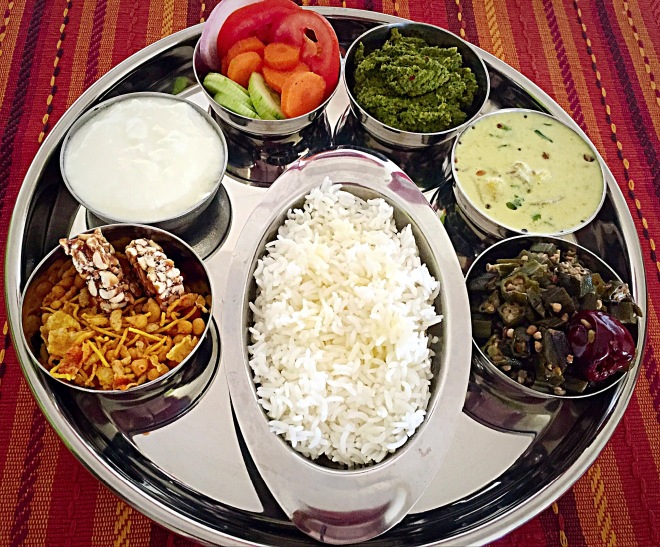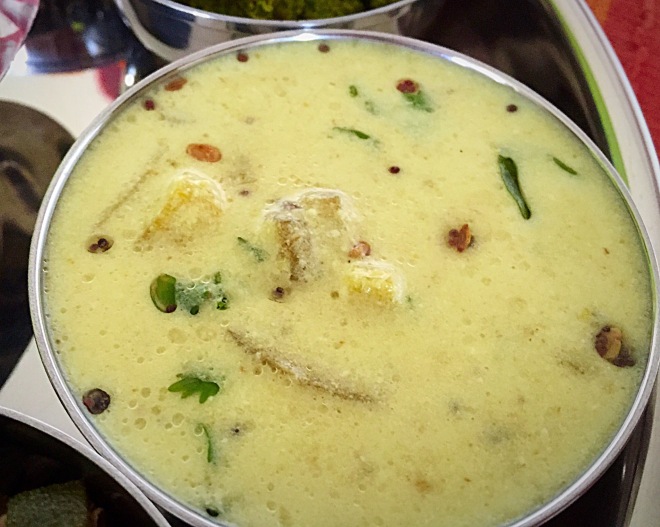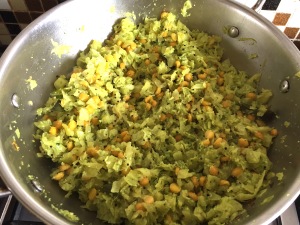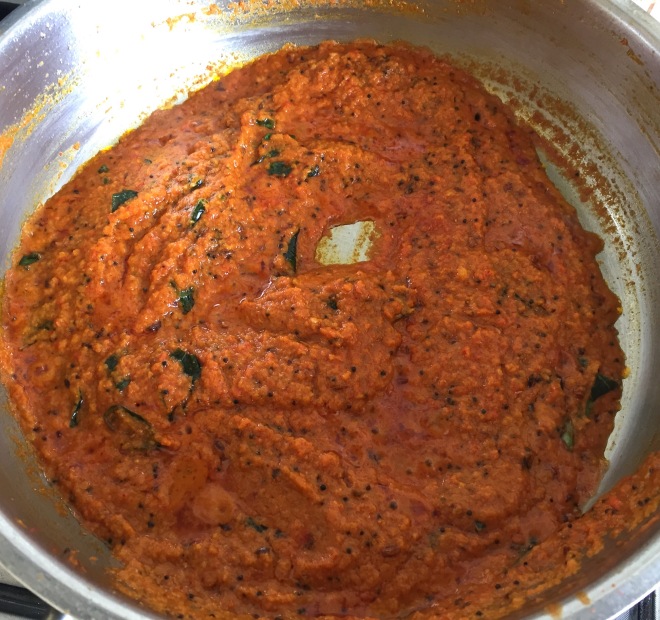Another simple South Indian lunch menu from my kitchen.
The best thing about South Indian cooking is that the amount of oil used for cooking is very less. Oil is basically used only for tempering.
Generally when I make morekuzhambhu( South Indian Kadhi), I add tomatoes to it. Today, I have added banana stem. Bansna stem is known as vaazhathandu in Tamil.
Banana stem is very healthy vegetable but my kids are not so fond of it. Since they like morekuzhambhu very much, I thought of combining both to make it more appealing for them.
Today’s lunch menu
——————
Vendaikai curry ( ladies finger / bhindi dry curry)
Vaazhathandu morekuzhambhu ( banana stem Kadhi)
Pudina kothamalli thogayal ( mint and coriander chutney)
Salad
Rice, yogurt, cornflakes mixture and peanut chikki

Vendaikai Curry
———————
Ingredients
Vendaikai- 1/2 kg
Oil – 2 tsps
Mustard – 1 tsp
Split urad dal ( black gram/ ullundhu)- 1 tsp
Red chillies – 2
Dry mango powder( amchur) – 1/2 tsp
Salt to taste
Method
Wash and chop the vendaikai.
Heat oil in a pan. Add mustard. When it starts spluttering, add urad dal and red chillies. Sauté for few seconds and then add the chopped vendaikai. Mix well.
Add the dry mango powder and salt to taste( dry mango powder is added to avoid the vendaikai becoming sticky. Instead of dry mango powder, lemon juice, chopped tomatoes or a tbsp of yogurt can also be added).
Mix well again. Close the pan with a lid and cook till the vendaikai becomes soft.

Vaazhathandu Morekhuzhambu
———————————
Tender banana stem- 12 inches long piece,1
Turmeric powder – 1/2 tsp
Salt to taste
Yogurt – 1+1/2 cups
Chopped coriander leaves – 1 tbsp
To grind to a paste
———————–
Grated coconut – 1/2 cup
Green chillies – 4-5
Ginger – 1/2 inch
Cumin seeds ( jeera) – 1 tsp
Almond flakes – 2 tbsp
Roasted chana dal ( chutney dal/ pottukadali)- 2 tbsps
For tempering
——————
Coconut oil – 2 tsps
Mustard – 1 tsp
Cumin seeds – 1/2 tsp
Fenugreek seeds ( methi/ vendhayam) – 1/2 tsp
Curry leaves – few
Hing ( asafoetida/ perungayam) – 1/8th tsp
Method
Remove the thick outer skin of the banana stem.
Before starting to cut the banana stem, mix little yogurt in a bowl of water and keep it ready.
Cut the stem into slices. When you cut a slice, you will find that there will be lot of fiber coming out. Remove it with your fingers.
Put the slices in the yogurt water mixture to prevent the discolouring of stem ( prevent oxidation).
Chop the slices into small cubes and again put it in the water yogurt mixture till required.
Before cooking, drain the banana stem well.
In a pan add the banana stem, turmeric powder, 1 cup of water and little salt and cook till the stem becomes soft.
Meanwhile grind the coconut, green chillies, ginger, cumin seeds, almond flakes and roasted gram to a smooth paste adding the required amount of water.
Beat the yogurt till it becomes smooth. Add the ground paste and 1/2 cup water and mix well.
Add this mixture to the cooked banana stem. Add salt to taste and mix well. Check for the seasonings and let it simmer.
Heat the coconut oil in a pan. Add mustard. When it starts spluttering, add the cumin seeds, fenugreek seeds, curry leaves and hing. Sauté for few seconds and add the tempering to the Morekhuzhambu.
Garnish with chopped coriander leaves and serve hot with steamed rice:)

Pudina Kothamalli Thogayal
——————————
Pudina – 1 cup
Chopped coriander leaves – 1 cup
Curry leaves – 1/4th cup
Grated coconut – 2 tbsps
Oil – 2 tsps
Urad dal – 2 tbsps
Red chillies – 3-4
Green chillies – 2
Ginger – 1 inch
Tamarind – little
Salt to taste.
Method
Wash the pudina, coriander and curry leaves well.
Wash and chop green chillies.
Wash, peel and chop ginger.
Heat oil in a pan. Add the urad dal, red chillies, green chillies, ginger and tamarind. Sauté till the urad dal becomes golden brown. Let it cool.
Drain the oil and remove the roasted ingredients. To the same pan, add the washed leaves and sauté for few mins. Let it cool. Add the coconut and salt to taste.
First grind all the ingredients except the urad dal to a coarse paste. Then add the urad dal and water and grind it for few more mins.

























































